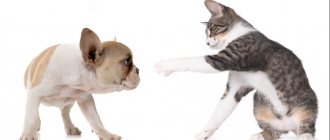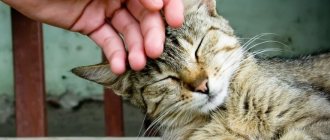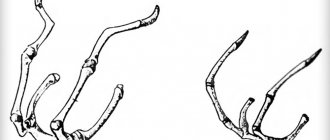The popular expression “they live like cats and dogs” usually implies hostility, however, the reality when it comes to domestic cats and dogs can be completely different. In fact, their peaceful coexistence under one roof is not only possible, but also easily feasible.
Dogs and cats are very different, but when they live in the wild, there are similarities in their lifestyle. Both species are quite antagonistic, although animals that have been socialized do not exhibit high levels of aggression.
Why do cats and dogs fight?
There are many legends and tales that explain such intransigence. For example, according to an old Chinese legend, one day a dog saved a little girl who was drowning. This girl turned out to be the daughter of a Chinese ruler.
As a sign of gratitude, the happy father attached a decree to the dog’s tail, which commanded that from now on every stray dog be fed and warmed. The dogs decided to throw a party. And in order not to lose the decree, he gave it to the cat for safekeeping. When the celebration was over, the dogs asked the cat to return this decree to them.
But it turned out that the precious paper had disappeared. The cat blamed the loss of the decree on the mice, who, out of envy, stole it and destroyed it. Since then, the cat and the dog have been at odds, and cats, in turn, do not like mice.
But every time they meet each other, the dogs sniff each other’s tails, hoping to still find what’s missing! But this, of course, is a legend. In fact, everything is much simpler.
Arming ourselves
Remember that meeting a dog and a cat can end in trouble for one or both of your pets. Therefore, prepare things in advance so that you can quickly separate irreconcilable enemies.
You may need a heavy, thick cloth that can be thrown over mating animals to separate them. Once in the dark , the animals will stop for a while and wait for further action on your part. If this does not help, then you can resort to drastic measures - pour several liters of water on their backs.
It is unlikely that the first meeting between a dog and a cat will end in serious injuries. However, in this case it will not hurt you to prepare the appropriate items:
- hydrogen peroxide;
- sterile cotton wool;
- bandages.
To avoid trouble, prepare a treat to reward the dog and attract the cat's attention. If you can feed two animals at once on the day you meet, then you can consider yourself a born parliamentarian.
Security measures
Also, it won’t hurt you to set up an enclosure or partition in advance so that the dog has less opportunity to get to the cat. Although, most likely, the cat will behave more aggressively Cats do not tolerate being restricted in their freedom; it’s a different matter with dogs, who take this quite calmly.
Let the cat first stand away from the dog, and then, if she has such a desire, you can allow her to approach the dog and sniff him through the bars. Do not forget to free your dog after meeting him, because you created the enclosure only in case you cannot control the behavior of the animals.
Causes of "enmity"
Territorial claims
The main reason that cats and dogs don't get along is territorial claims. A dog is a pack animal. The ancestors of dogs (wolves) hunted prey together and protected their territory. Cats are loners by nature. But those others are also predators. And every predator (even though it has become domesticated) retains its natural instincts to defend its territory.
Hunter's Instinct
Another reason for the enmity between cats and dogs is that cats, without meaning to, can provoke a hunting instinct in a dog. Loners by nature, cats do not like their personal space being violated.
Dogs are the opposite. Good-natured and sociable, they poke their curious wet noses everywhere. A good-natured dog can approach a cat with the best intentions. The same one can either slap him in the face or run away. Well, a running cat instantly awakens the dog’s passion for hunting.
Many dogs, when chasing cats, regard it as a game or fun. Having driven a cat up a tree, the dog is unlikely to want to harm it. He simply “turns on” the hunter and wants to play catch-up. But a cat driven into a tree regards this completely differently, gets very angry and hisses. Well, as you know, cats always remember the insult caused to them. Even if a cat and a dog are on friendly terms, seeing a cat running away may awaken the dog’s natural instincts as a hunter.
Differences in behavior
Also, one of the reasons for “dislike” between cats and dogs may be differences in behavior and misinterpretation of these differences by animals. For example, when a dog wags its tail, it means a friendly mood, an invitation to play.
A cat wags its tail when it doesn't like something or is angry. A dog, seeing a cat's tail wagging, regards this as a call to play. But a cat can perceive a dog's wagging tail as a sign of aggression.
Jealousy
Well, another, no less significant reason for enmity is jealousy. In general, the most ideal option is a situation where a cat and a dog appear in the house at the same time, at a very early age. In this case, they grow up side by side and become allies and best friends. But this happens extremely rarely.
As a rule, a kitten or puppy is brought into a house where an adult dog or cat already lives. The likelihood that animals will become inseparable friends is very low. And here the main task of man is to create all the conditions and teach them peaceful coexistence.
That was a long time ago…
And again about genetic memory. She seems to be the only explanation for the dog's eternal pursuit of the cat. Some childish question that excites the minds of adults and serious people, to which, apparently, there is no clear answer: “Why don’t dogs like cats?”
Some semblance of an adequate explanation can be found in the prehistoric period, when saber-toothed tigers (one of the most dangerous representatives of the cat family) walked the earth and brutally exterminated the canine family.
Dogs in those days were not distinguished by their gigantic sizes, they also did not have huge “saber” teeth, so many of them fell victims to ruthless “cats”, which were superior to dogs in size, sharpness of teeth, and cruelty.
And now, when the cats have “shrinked” to the size required by the dogs, they took a kind of carte blanche and considered themselves authorized to avenge the death of their ancient ancestors.
A kitten appears in the house
Let's consider a situation where you already have a dog and you decide to get a kitten. In the minds of dogs, especially dogs of hunting breeds, which is what my Jack is, a cat is a subject of hunting. You will have to carefully and patiently explain to your four-legged pet that the kitten is now a member of your “pack.”
Before the cat and dog meet, the dog should have a good walk outside to be calm and tired. When you first meet, be sure to keep your dog on a leash and let the animals sniff each other. Keep calm. Don't raise your voice.
If the dog behaves well, praise it and give it a treat. If the dog begins to attack the kitten, strictly command: “Ugh!” and pull it back. Talk to the dog, calm him down. At first, pay her more attention so that she does not feel left out.
The most ideal way would be to start by locking the animals in different rooms so that through the gap under the door they can get used to each other's smell. The cat and dog should not be left alone indoors until you are completely sure of their “truce”.
Remember all
Another reason why dogs don’t like cats is often the good memory that all dogs have. If a dog is quite belligerent against a cat, he angers and irritates it, which means that he has already experienced a bad experience of meeting a purring dog, in which the dog could have been injured (often cats, desperately defending themselves, deeply scratch the noses of curious dogs and injure the mucous membrane of the eyes).
How can a self-respecting dog forgive and forget this? There are no options here - for the pain and humiliation experienced, the dog will begin to take revenge on all the cats in a row.
A puppy appears in the house
When a puppy appears in the house, the situation is completely different. The puppy absolutely calmly accepts all the cat’s moral teachings and obeys its rules. In this case, the cat is usually dominant.
If the dog becomes too curious and begins to “pick up” the cat, the cat begins to hiss and hit the puppy with its paw, forcing the four-legged baby to behave decently.
Of course, gradually the cat and dog begin to get along with each other. They sleep side by side and play happily. But this only applies to those animals that live together in the same house.
If there is no friendly relationship between a cat and a dog, then the dogs will chase other people's cats in the same way as the object of the hunt. And cats, in turn, will hiss and bully other people's dogs. And to prevent this from happening, you need to follow some rules from a very early age that will allow you to avoid unpleasant moments.
Advantage of the Pack
The joint actions of social animals, which are canines, have many advantages over individualistic cats, who are forced to independently take care of their food and safety:
- A threat to singles . Despite caution and developed instincts, small and medium-sized cats in nature become frequent prey for canines. Thus, the young of the European forest cat are devoured by wolves, foxes and jackals, the slow-moving Pallas cats are successfully hunted by wolves, and the light-footed coyote easily catches up and kills stray cats. A lynx, although it weighs one and a half to two times less than a wolf, poses a serious danger in single combat with it. At the same time, wolves hunting in a pack surround the fleeing lynx, attack in a group and tear it to shreds. Hunters know that in places where there are a lot of wolves, “the lynx doesn’t stick around.” A seasoned lynx, scared from its resting place, flees from a pack of hunting dogs and can run up to 4-6 km before its strength begins to run out. The overtaken animal accurately assesses the situation and, being pursued by one dog, takes up a perimeter defense and fights on the ground. Moving away from the pack, the lynx uses a trivial cat trick and climbs a tree, hoping to sit there. If a shot from a hunter who arrives in time does not kill it outright, then a wounded cat falling down can seriously injure and even kill the dog, desperately clinging to life.
- Run, murka, run! The pack lifestyle allowed dogs to occupy a dominant position even in the conditions of the “concrete jungle,” forcing cats to habitually retreat. Undoubtedly, the difference in size plays a significant role, but even terriers weighing 5-8 kg frantically chase the neighbor's cats, feeling like they are the masters of the area. Thanks to its flexibility and maneuverability, the running cat demonstrates the skill of parkour, avoiding obstacles and climbing to a saving tree or other height inaccessible to the enemy. A single chase most often turns out to be fruitless, but a flock can push the cat away from the shelter and collectively work for destruction.
Rules of conduct and prohibitions in the relationship between a cat and a dog
Try to do this:
- Never allow your dog to chase a cat, including other people's cats on the street.
- Before the cat and dog meet, the dog should have a good walk outside to be calm and tired.
- At first, the cat and dog can be locked in different rooms so that through the gap under the door they can get used to each other’s smell.
- After the animals adapt, you can get to know them better. During the first meeting, keep the cat in your arms and the dog on a leash to avoid direct contact.
- Give the animals equal attention so that none of them feel left out.
- Give both animals a treat. Let the first acquaintance be associated with positive emotions.
- Cats and dogs must each have their own sleeping place.
- Everyone should also have their own feeding bowls. It is better if they are at different levels (higher for a cat). This is necessary to prevent the dog from eating cat food. The principles of feeding a cat and a dog are different. Food is put on the dog so that it eats it right away. If the dog does not eat its food within 10 minutes, the bowl is removed. The cat is the opposite. The food is placed in a bowl, and the cat comes and eats it in small portions throughout the day.
- The cat should always have a place to retreat (closet, stairs, etc.) so that if the dog's hunting instincts awaken, it can hide.
- Make sure that the dog does not interfere with the cat doing its business in its toilet.
- If you are going to the country, then the cat and dog should be with you. No animal should feel abandoned.
Today we talked about what needs to be done to ensure that a cat and a dog get along as painlessly as possible in your home. Remember, to ensure peaceful relationships between animals, they must be under your close attention at all times. And most importantly: so that the cat and dog do not feel deprived, give them your love and attention equally.
Exceptions to the rules
It turns out that not all dogs dislike cats. There are breeds that adore fluffy purrs. These include:
- Papillon.
- Bichon Frize.
- Maltese.
- Basset Hound.
- Pug.
- German boxer.
- Newfoundland;
- Golden retriever.
In representatives of some breeds, hunting and fighting instincts cannot be suppressed through education. Owners of pit bulls, greyhounds, and Parson-Russell terriers will have to train their pets, teaching them not to pay attention to cats and not to succumb to their provocations.











